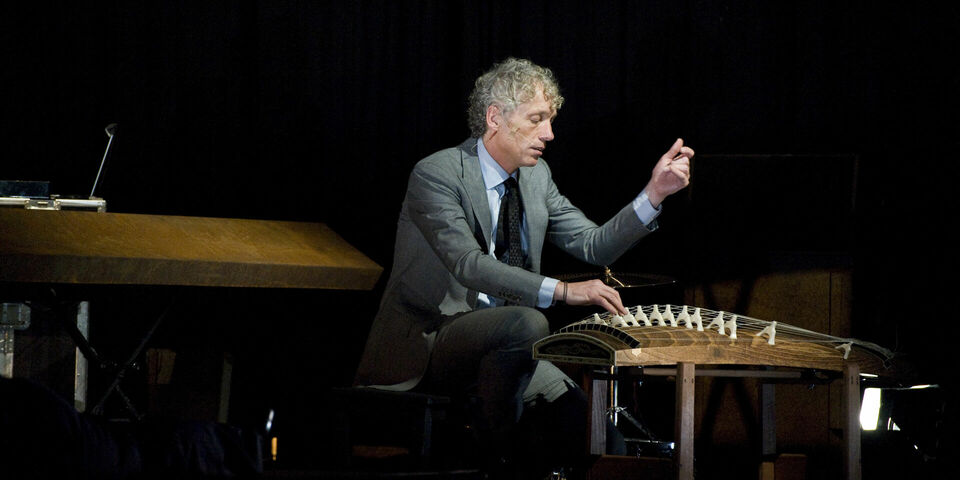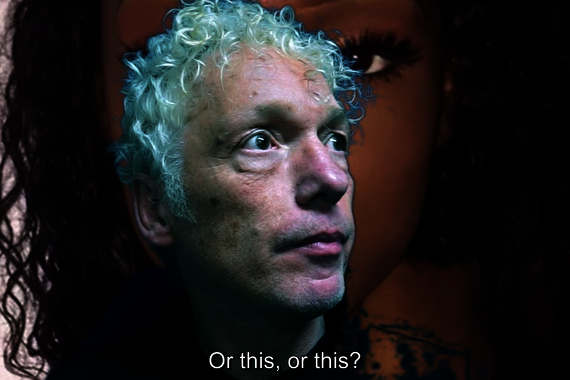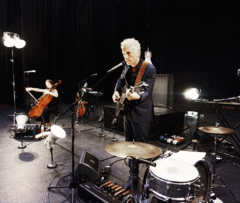Discover beauty in science with Spinvis
Who wants to explore beauty in science? Journey into the unknown? In September and October, twenty-five students will have an opportunity to go on a wondrous voyage of discovery with musician and artist Spinvis. He will be the first ‘Artist in residence’ at TU/e and will lead Expeditie Spinvis. “There’s so much more spirit in scientists than the outside world thinks.”
It seems an unlikely combination, a poetical composer and twenty-five science students. But Spinvis, whose birthname is Erik de Jong, isn’t exactly the kind of person who believes in old stereotypes. “The division between creative arts and humanities students on one side, and exact scientists on the other falls short. Science can often be quite humorous. Mathematicians are poets. I come from a family of scientists, my father and brother are mathematicians. Personally, I’m more attracted lo language. But math and logic are a language as well. We can only express ourselves through language, both in science and in poetry. They’re not that far apart.”
Artist in residence
Spinvis will give six workshops in September and October. Expeditie Spinvis will take place in TU/e innovation Space on Friday afternoons. The meetings will be conducted in English. The guiding principle is the search for beauty in science. Joep Huiskamp, member of TU/e’s management staff, persuaded Spinvis to come to TU/e. “He’s our first artist in residence. It’s part of our vision of challenged based learning, to present students with a different perspective on matters, outside the curriculum. Think of it as a pilot. If it proves successful, we’ll turn it into an annual project.”
Sign up
Students can sign up until the 24th of June through this link. Spinvis asks students to send in a one-minute motivational video in which they present an object that symbolizes beauty to them and explain why the object is so beautiful. In this video, Spinvis explains why taking part in his expedition is so valuable.
Journey into the unknown
Spinvis: “I think the word expedition is well chosen. The students who take part should prepare for a journey into the unknown. I’m not a teacher of course, I’m just curious and I like to share my curiosity with my fellow travelers. I have a plan, but I have no idea where we will end up. And that’s the idea behind it.”
That might sound a bit vague, he admits, but there is a method to it. The members of the expedition will not only take part in six workshops and three public performances, they will also travel to Switzerland where European research organization CERN conducts fundamental research on elementary particles.
CERN
The project will start with a public lecture by Spinvis on September 13. The participants will visit CERN the next day. The visit was made possible in part by (former) TU/e researchers who work in Switzerland. The workshops will take place next, from September 20 to November 1. Halfway through, on October 9, the public will be given a glimpse of the work in progress. On November 6, Expeditie Spinvis will conclude with a film in which Spinvis and the members of the expedition sum up their journey in images, music and text.
I think the word expedition is well chosen. The students who take part should prepare for a journey into the unknown.
Film
Spinvis: “I gave a similar masterclass at TU Delft in 2013. That was great, but it lacked a final project. Of course, the journey itself is what gives greatest pleasure. Philosophizing, asking each other questions, this is what’s most interesting. But the audience doesn’t witness that. We did give a presentation. That was a good story, but it wasn’t an accumulation of the things we discussed. I want to prevent that now. I want our film as accurately as possible to incorporate every thought we develop. We will shoot one or several scenes per masterclass. The film that we will eventually present to the world will elucidate and explain beauty in science. The format you choose may be as psychedelic as you want. It’s a poetical assignment. I don’t pretend to make something that has any scientific value. It helps when we give our brain a good workout and think in a completely different way.”
The composer Spinvis is known for his carefully wrought lyrics and music. He is especially well known and successful in the Netherlands and Belgium. He will be scaling back his performances momentarily during the TU/e masterclass. This performance during Lowlands in 2018 is a good example of his work, as is this special rendition of his small hit Smalfilm.
Beauty
The first question that needs to be answered during this search is what defines beauty. Spinvis: “That is culturally defined and universal at the same time. The workshops will be held in English in order to include as many people from different cultures as possible. Music, food, clothes, manners, people can be touched by things that are meaningless to others.” Spinvis, who is known for his carefully structured lyrics in Dutch, acknowledges that this decision has a limiting effect. “But it has added value because it allows us to paint with more colors.”
Spinvis is looking for participants with an open attitude who do not expect clarity and sharply defined assignments. Curious and open-minded bachelor’s and master’s students, graduates, PDEng’s and PhD students with different capabilities and qualities will join forces. “It’s an uncommon way of working. You have to enjoy it, but at the same time there needs to be progress. It’s not free of obligations. I will play a guiding role.”
My question: is this longing for a parallel universe simply a human desire we wish to see fulfilled? Does nature work differently?
Symmetry
Symmetry, truth, simplicity and the Theory of Everything are key concepts to Spinvis. “CERN is a cathedral of knowledge and conducts experiments that prove, or not, the acceptable theory of a mirror universe that exists next to our own in which everything is synchronous; an ever-present universal balance. Supporters and opponents of this theory are deeply divided, almost religiously so. My question: is this longing for a parallel universe simply a human desire we wish to see fulfilled? Does nature work differently?”
“Yes, this certainly is a source of inspiration, but I’m not going to write a song about symmetry. It’s obvious that science influences art. I’m in a studio surrounded by computers, samplers and other digital stuff. These are the fruits of science that ended up in the hands of artists. Conversely, it’s more difficult to define the influence of art on science. They used to belong together, but art and science grew apart. They’re still married in a way, but the exact relationship is difficult to determine.”




Discussion